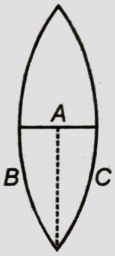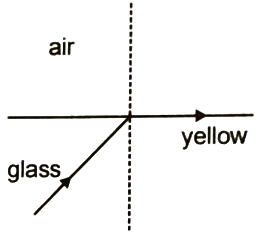A liquid of refractive index \(\frac{4}{3}\) is placed between two identical planoconvex-lenses touching each other at their spherical surfaces of radius \(R\). If the refractive index of the lens is \(1.50\), then the lens behaves as:
1.
a convergent with power \(P=\frac{1}{3 R}\)
2.
a convergent with power \(P=\frac{1}{6 R}\)
3.
a divergent with power \(P=\frac{1}{3 R}\)
4.
a divergent with power \(P=\frac{1}{6 R}\)
A prism of refracting angle , has one of the refracting faces polished. A beam of light incident on the other refracting face with i = will retrace its path, if the refractive index of prism would be
1.
2.
3.
4.
A convex mirror of focal length \(20~\text{cm}\) forms an image that is a quarter of the object's size. The distance of the object from the mirror is:
1. \(50~\text{cm}\)
2. \(-60~\text{cm}\)
3. \(-40~\text{cm}\)
4. \(-70~\text{cm}\)
Two thin convex lenses of focal length 20cm and 5cm are placed 10cm apart. The power of the combination of lenses is
1. 10D
2. 15D
3. 20D
4. 25D
The maximum magnification which can be obtained with the help of a simple microscope is 6. If a point object is placed at distance 3 cm from the microscope, then what was be the position of the image?
(1) -7.5 cm
(2) -6.4 cm
(3) 8.2 cm
(4) 5.45 cm
A converging spherical wavefront is obtained from
(1) Light emerging from a convex lens when a point source is placed at its focus
(2) A parallel beam of light incident on the convex lens
(3) Light converging at a point
(4) Both (2) & (3)
A ray is incident normally on a right-angled prism whose R.I is and prism angle . Deviation to the ray is equal to
(1)
(2)
(3)
(4) 2
Two convex lenses of focal lengths are separated co-axially by a distance d. The power of the combination will be zero if d equals to
1.
2.
3.
4.
A thin equiconvex lens of power P is cut into three parts A, B, and C as shown in the figure. If are powers of the three parts respectively, then

1.
2.
3.
4.
A light beam containing red, yellow and blue color, falls on the interface of glass-air as
shown. If the yellow light is just totally internally reflected then emergent ray in air contain

1. Both red and blue color
2. Only red color
3. Only blue color
4. No color






